
Citrus nutrition
Series: Agfact H2.3.11 Edition: Second edition Last updated: 31 Dec 2002
Warning
Pesticide residues may occur in animals treated with pesticides, or fed any crop product, including crop waste, that has been sprayed with pesticides.
It is the responsibility of the person applying a pesticide to do all things necessary to avoid spray drift onto adjoining land or waterways.
Always read the label
Users of agricultural (or veterinary) chemical products must always read the label and any Permit before using the product, and strictly comply with the directions on the label and the conditions of any Permit. Users are not absolved from compliance with the directions on the label or the conditions of the Permit by reason of any statement made or not made in this publication.
Disclaimer
The product trade names in this publication are supplied on the understanding that no preference between equivalent products is intended and that the inclusion of a product does not imply endorsement by NSW Agriculture over any other equivalent product from another manufacturer.
Introduction
Citrus trees are demanding feeders and are prone to many disorders related to mineral nutrition. In New South Wales, citrus suffer from deficiencies of at least eight of the thirteen essential elements which plants obtain from the soil. Common deficiencies are:
- nitrogen (N), phosphorus (P), potassium (K) and magnesium (Mg)—major elements;
- zinc (Zn), manganese (Mn), iron (Fe) and copper (Cu)—minor or trace elements.
Citrus species are also sensitive to an excess of certain elements in the soil or the irrigation water, especially to an excess of chloride, sodium, boron and manganese, which can injure the trees.
Nitrogen (N)
Functions of nitrogen
Nitrogen is the element that has the greatest effect on citrus production, and citrus needs more nitrogen than any other nutrient.
Nitrogen is a component of chlorophyll (the green pigment in leaves), and is associated with important tree functions such as growth, leaf production, flower initiation, fruit set, and fruit development and quality.
Shortage of nitrogen
A nitrogen shortage causes the loss of green colour from the leaves, resulting in an even paleness. A deficiency of nitrogen in the spring makes the leaves pale and small. Old leaves shed early in the season, causing the foliage cover to become thin, and twigs to die back. Tree growth is retarded, and cropping suffers through poor fruit set and smaller fruit.
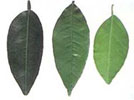 Leaves of an orange tree showing increasing paleness due to nitrogen deficiency. Left to right: normal healthy leaf, leaf slightly deficient in nitrogen, and leaf very deficient in nitrogen. The loss of green colour occurs evenly over the leaf. | 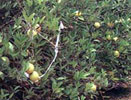 Nitrogen deficiency dramatically affects tree growth and production. Leaves deficient in nitrogen are pale, narrow, upright and slightly rolled; foliage is thin due to leaf fall, and twigs die back, giving the tree a brushy appearance. | 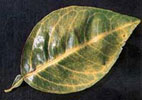 Vein clearing in the leaves of an orange tree is usually associated with root injury or girdling, but may occur when normally well fertilised trees are suddenly deprived of nitrogen. |
Excess nitrogen
Too much nitrogen lowers fruit quality and shortens storage life. The fruit is large and puffy, maturity is delayed, and regreening increases. The skin thickens and becomes coarse, while the percentage and quality of the juice decline. The colour takes longer to break in oranges, and in navels rind staining increases. The adverse effects of high nitrogen are worse when phosphorus is low. Excess nitrogen promotes lush tree growth and late flushes which are susceptible to frost.
Nitrogen fertilisers
Nitrogen fertilisers include ammonium nitrate, urea, ammonium sulphate, ammonium phosphates, and compound or mixed NPK (nitrogen, phosphorus, potassium) fertilisers. The nutrient percentages in common citrus fertilisers and manures are given in Table 1. District fertiliser rates are given in Table 2.
The form of the nitrogen in the fertiliser affects its performance and determines the suitability of a fertiliser for a particular situation. However, the cost per kilogram of nitrogen is usually the deciding factor as to which fertiliser is chosen. The nitrate in ammonium nitrate moves quickly and easily to the roots, but it can be lost through leaching by heavy rain. Ammonium fertilisers, such as ammonium sulphate, are less liable to leaching, but they tend to make the soil very acidic after years of regular use. Per unit of nitrogen, ammonium nitrate is only one-third as acidic as ammonium sulphate.
Urea is a cheap and concentrated nitrogenous fertiliser. Cultivate or water it into the soil to prevent it from volatilising as ammonia. Urea used as a foliar spray is absorbed into the leaves in a few hours; but the amount of nitrogen applied in a single spray is small (less than 10 kg N/ha). Foliar-applied urea is therefore used to supplement, rather than replace, normal applications of fertiliser to the soil. This can give an extra boost when needed (for example, when a heavier crop than expected has been set). Urea used for spraying should have a low biuret content (less than 0.4%), as higher levels cause leaf burn. Biuret is not a problem when urea is applied to the ground.
Phosphorus (P)
Functions of phosphorus
Phosphorus performs many vital functions in the plant—in photosynthesis, in enzyme activity, and in the formation and movement of sugars. It is important in flowers and developing fruit.
Shortage of phosphorus
It is rare for tree growth or yield to be affected by low soil phosphorus in the orchard, or for deficiency symptoms to be seen in leaves. Where such extreme deficiency does occur, leaves are a dull bronzed green and they shed readily. Low phosphorus affects fruit quality, causing misshapen fruit with open centres and coarse, thickened rinds. The fruit is pulpy and has a low juice percentage, and the juice is acidic. The quantity of total soluble solids (sugar content) of the juice is usually not affected. The effect of phosphorus deficiency on fruit quality is worse when too much nitrogen fertiliser has been used. A balanced supply of nitrogen and phosphorus gives both a high yield and good fruit quality.
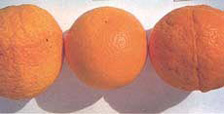 Excess nitrogen combined with low phosphorus can adversely affect fruit appearance and quality. The oranges on the left and right received high levels of nitrogen fertiliser and no phosphorus. This caused the fruit to be misshapen and the rind to be coarse and roughly textured. The fruit in the centre received a moderate but sufficient level of nitrogen, and adequate phosphorus. | 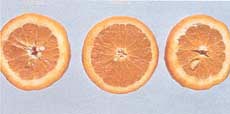 The two outer pieces of dissected fruit show thickened rinds, open centres and coarse flesh, caused by high nitrogen and no phosphorus. The thin-skinned fruit in the centre received adequate phosphorus and a moderate nitrogen level. |
Excess phosphorus
Too much phosphorus does not cause any loss in yield or fruit quality, but it can accentuate the effects of zinc deficiency in the trees.
Phosphorus fertilisers
Phosphorus is supplied in superphosphate, ammonium phosphates (MAP or DAP), and NPK compound fertilisers (see Table 1). Poultry and animal manures, if used at high rates for at least 4–5 years, contribute to soil phosphorus supplies. Phosphorus fertilisers are also used to promote cover crops or legume-based sod in citrus blocks. Foliar sprays are not effective in supplying phosphorus to fruit trees.
Reserves build up in the soil after many years of regular phosphorus fertiliser use. Phosphorus can then be omitted for several years or applied every second or third year. Leaf analysis is the best way to monitor continuing needs.
Potassium (K)
Functions of potassium
Potassium is important in the formation and functioning of proteins, fats, carbohydrates and chlorophyll, and in maintaining the balance of salts and water in plant cells.
Shortage of potassium
Potassium deficiency symptoms vary in citrus. They are often not easy to recognise, and can be mistaken for other problems. Symptoms include slower tree growth, small leaves and a heavy leaf fall, often preceded by the leaves turning yellow or bronze. Dieback follows in the weakened twigs, and bloom decreases. In late summer the pattern of leaf yellowing is irregular and blotchy, with most yellowing starting near the apex half of the leaf. The yellowing later becomes bronzed and more irregular in pattern. Fruit are small; the skin is thin and smooth, tends to colour early, and splits easily. Creasing is more prevalent.
Mild deficiency does not affect the yield, although the fruit may be smaller. Severe potassium deficiency reduces the yield by causing heavy flower and fruit drop.
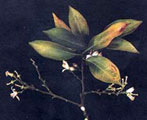 Potassium deficiency symptoms are usually most prominent in the spring. Brown irregular patches and yellowing appear near the apex of the leaf, while the base of the leaf is last to lose its colour. Leaf fall follows. Note the bare lower twigs. |  The yellowing pattern seen in potassium-deficient leaves varies during the season. A diffuse bronze-yellow is commonly seen in the spring. | 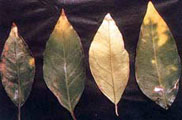 Irregular yellow blotching from potassium-deficiency is more common in late summer. |
Excess potassium
Surplus potassium delays maturity and causes oranges to become coarse, large, more acidic, and less juicy. The rind thickens and becomes rough, and regreening increases. A potassium excess does not affect lemon quality. Too much potassium can accentuate magnesium deficiency.
Exchangeable potassium is the most readily available soil potassium supply. It is slowly replenished by reserves. In general, sandy soils have less potassium than heavier soils. Most potassium is found near the surface. Drought can reduce the uptake of potassium from dry surface soil, leading to a temporary shortage.
Potassium deficiency is not often seen in commercial citrus areas of New South Wales. It was prevalent in the Gosford area during World War II, when potash fertilisers were difficult to buy. Regular use of NPK fertilisers has nearly eliminated the deficiency; in some orchards, soil reserves of potassium have been built up to luxury levels.
Potassium fertilisers
Potassium deficiency can be corrected by applying potassium chloride (muriate of potash) or sulphate of potash, or by using mixed or compound NPK fertilisers (see Table 1). Potassium chloride (muriate) is cheaper than sulphate of potash and can be used in all situations except those where salinity is a problem.
To correct a severe potassium deficiency, spread a large single application (1-2 kg K/tree) in a band around the drip ring. This gives the fastest recovery. As potassium does not readily leach from most soils, the effect will last for several seasons. This method is cheaper than applying smaller amounts annually. However, many growers, particularly coastal growers, find it convenient to maintain potassium supplies through regular annual applications of compound NPK fertilisers, applying 100–340 grams of potassium per tree. Do not continue annual treatments indefinitely without monitoring potassium levels using leaf analysis. Potassium can be applied as a foliar spray of potassium nitrate, but the quantity given in a single spray is very small when compared with the needs of the tree.
Continued fertilising with potassium over many years can build potassium up to unnecessarily high levels. Potassium is expensive, especially when bought in mixed fertilisers, and using more than is needed is a waste and can be harmful.
Using fertilisers
Timing
Nitrogen
Timing is critical when using nitrogenous fertilisers. A sound fertiliser program will provide enough nitrogen in spring to promote flowering and fruit set. At the same time it has to meet the needs of the growing crop and tree. Judicious timing also minimises the adverse effects on fruit quality of absorbing too much nitrogen late in the season.
Apply nitrogen fertiliser several weeks before flowering, that is, in late June to early July for coastal areas, or in late July for inland districts. In sandy coastal soils, where leaching is high, it is common to split the dressing into two applications—two-thirds in late winter, with the rest spread in the period from December to February.
Apply organic manures in autumn. This allows them time to break down and release the nutrients for spring growth.
Timing is important when spraying urea. To avoid loss of fruit quality, apply urea sprays to fruit-bearing trees from late October to mid-December.
For young trees (to 4 years), split the nitrogen applications into three equal applications (in winter, spring and late summer). This practice promotes good vegetative growth, lessens the risk of fertiliser burn and reduces waste through leaching beyond the immature root systems of young trees.
Phosphorus and potassium
The timing is less important for applying phosphate or potassium fertiliser than it is for nitrogen fertiliser. These two elements leach very little, and they take from 3 months to 3 years to be absorbed into the tree.
Apply phosphate in March. This gives most benefit to winter cover crops and allows time for the phosphate to be absorbed before spring.
Apply mixed NPK fertilisers in late winter at the same time as the main nitrogenous fertiliser.
Placement
Nitrogen
Fertilisers are either broadcast (spread on the surface over the area between the rows) or applied in a strip or band near the edge of the canopy. Broadcasting is the main method of applying nitrogenous fertilisers and mixed fertilisers to mature trees.
Young trees need to have fertilisers spread within reach of their root systems. This is done in a broad band running from about 15 cm from the trunk to about 50 cm beyond the canopy.
Double-planted trees that are 3–4 years old need the fertiliser spread in two bands, 1–2 m wide, on each side of the row, and at least 50 cm from the tree butts.
Phosphorus and potassium
Phosphorus and potassium do not move freely in soils and are slow to reach the roots. In heavier soil they tend to stay where the fertiliser is applied (usually the surface). Broadcasting phosphorus can be ineffective, or uptake delayed, especially where the soil has high phosphorus-holding powers. Frequent root-cutting cultivations, dryness, and high surface-soil temperatures limit absorption from the top few centimetres, where most of the phosphorus (or potassium) tends to stay. These conditions make it difficult to quickly correct phosphorus and potassium deficiencies in an established orchard.
Banding is the best way to apply superphosphate and potash fertiliser to citrus trees. The banded fertiliser is spread on the surface or buried in a furrow. Deep placement (15–20 cm) ensures good uptake as the roots grow through the band; on the other hand, furrows cause root disturbance. To avoid repeated root disturbance, apply enough superphosphate for 3–4 years in one dressing. A surface band close to the drip ring is effective in light textured soils. Broadcasting superphosphate between the rows is ineffective in supplying the needs of the tree. Do not place high rates of muriate ofpotash deep in the soil, as there is a risk of injury from the high chloride concentration.
A single heavy application (up to 5 kg per tree) of superphosphate placed under the tree, extending to just outside the drip ring, will hasten uptake. Downward movement of phosphorus to the roots is slow, therefore management practices may need to be changed to encourage feeder roots to grow to the fertilised soil surface. Organic matter improves phosphorus movement. Sod culture methods and mulches encourage roots to forage nearer the surface.
Fertigation
Many modern, under-tree irrigation systems lend themselves to fertigation (a combination of fertilisation and irrigation). It is a simple and efficient way to supply the trees’ needs, and has the following advantages:
- Fertiliser is applied to the irrigated part of the root zone, which is usually the area of greatest root activity. This can lead to more efficient fertiliser use.
- Fertiliser applications are flexible to suit growth stage and crop demand. The fertiliser rates can be quickly adjusted to crop need.
- Nutrients are quickly available.
- There are savings in labour, time, equipment and fuel costs.
- There is less traffic in the orchard, which reduces soil compaction.
- Water and nutrients in the root zone are accurately controlled. This is especially important in sandy soils with low retention properties.
- The uptake of nutrients is improved, resulting in less leaching and less pollution of ground water.
Fertigation procedures
Apply nutrients towards the middle of irrigation and stop shortly before the irrigation is complete. Keep irrigating until the lines are flushed free of fertiliser; however, avoid deep leaching of nutrients.
Fertilisers
Materials must dissolve easily, remain stable in the pipes, and not react with pipes or dippers, or cause blockages.
- Nitrogen and potassium are most suited to fertigation.
- Phosphorus applications are not usually recommended, as phosphates react with calcium and magnesium in irrigation waters causing precipitation in the lines or outlets.
- Most nitrogen and potassium fertilisers are compatible.
- Do not use calcium and phosphorus fertilisers together.
Table 3 lists some of the fertilisers commonly used for fertigation.
Trace elements can cause clogging problems, and some remain localised in the soil, preventing effective uptake. Chelated trace elements are more stable and less likely to cause clogging. However, the effectiveness of this method of correcting trace element deficiencies in fruit trees has yet to be fully proven.
Nitrate is very mobile in the soil and moves to the edge of the wetted zone. Excess irrigation can result in leaching beyond the roots. The ammonium form of nitrogen is held in the soil near the irrigation outlets until soil bacteria change it to nitrate, which then moves outward. Urea is briefly mobile, and moves through the soil until it is changed to the ammonium form. It is then held in the soil until it is converted to nitrate.
Potassium tends to be held in most soils, and is not usually leached under fertigation. The common potassium fertilisers are potassium chloride (muriate of potash), potassium nitrate and potassium sulphate, which are readily soluble in water and cause few precipitation or clogging problems. Do not use potassium chloride where salinity is a problem.
Long-term fertigation with ammonium fertilisers or urea causes localised soil acidification in the wetted zone. It is ineffective to lime the surface, but calcium nitrate, substituted as the source of nitrogen, will help counteract the problem. Ammonium sulphate makes the soil very acid and should only be used in highly alkaline soils.
Timing
Fertigation, in split applications, should be timed to provide nitrogen in demand periods. Limit it during late fruit development to avoid quality loss. Fertigation gives a quicker nutrient uptake than surface broadcasting fertilisers. Start nitrogen applications shortly before flowering. Follow this with two or more nitrogen fertigations, ceasing applications to oranges after January.
Rates
There is conflicting evidence on whether fertiliser rates can be significantly reduced for fertigation as compared with surface-applied fertilisers. If you are using fertiliser rates that are lower than standard rates, analyse the leaves to ensure the trees are adequately fed (see Leaf analysis).
Calcium (Ca) and magnesium (Mg)
Symptoms of calcium deficiency are rarely seen in citrus orchards, but magnesium deficiency occurs in most districts in New South Wales. Magnesium deficiency is common in the leached acid sandy soils of the Central Coast, but it can also be found inland.
Magnesium deficiency produces a very distinct yellowing towards the apex of the older leaves, with a triangular area remaining green at the leaf base. Affected leaves fall prematurely in late summer and autumn. The defoliation can be heavy when a large crop is being carried. If the deficiency is not corrected it weakens trees.
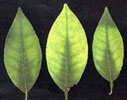 Magnesium deficiency in orange trees results in a distinct yellow pattern in the older leaves. The yellowing begins near the edge and towards the apex, leaving a triangle of green at the base of the leaf. | 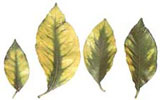 Magnesium deficiency in lemon trees also results in a distinct yellow pattern in the older leaves. The yellowing begins near the edge and towards the apex, leaving a triangle of green at the base of the leaf. | 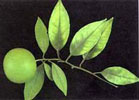 Magnesium deficiency affects the older leaves first—note the young leaves are showing no pattern. A heavy crop can accentuate the deficiency in late summer, leading to a heavy fall of the yellow leaves in autumn. The tree can be left severely defoliated and weakened. |
Spray in late spring for the quickest response (see Table 4). The spray does not give long-term correction and must be repeated each year. Longer correction can be obtained from a soil application of magnesite or dolomite (Table 4); however, it may take 2–3 years before the symptoms disappear. The best way to overcome a severe deficiency is to combine soil treatment with sprays during the first two seasons.
Trace element deficiencies
Deficiencies of zinc, manganese, iron, copper and boron are found in New South Wales citrus. Zinc and manganese deficiencies are the most common. Both occur widely in all districts—on coastal acid soil as well as the alkaline inland soils. Spray treatments for correcting trace element deficiencies are given in Table 4.
Zinc (Zn)
Zinc deficiency, described as ‘little leaf’, ‘mottle leaf’ and ‘rosetting’, is one of the most damaging and widespread nutritional disorders of citrus. Leaf analyses conducted by NSW Agriculture have shown that over 60% of citrus orchards are low in zinc. The deficiency is most acute in alkaline soils. It also affects citrus growing on acid coastal soils.
Even in its earliest stages, zinc deficiency lowers yield, reduces tree vigour and makes fruit small and poor in quality. Leaf symptoms include small, narrow leaves (little leaf) and whitish-yellow areas between the veins (mottle leaf). Leaves also crowd along short stems (rosetting), and smaller twigs die back. Symptoms are often more pronounced on the northern (sunny) side of the tree.
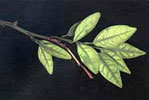 Zinc deficiency produces a bright creamy-yellow mottle. Leaves remain small and narrow (‘little leaf’) and stems are short, giving growth a bunched appearance. Symptoms are usually worse on the northern (sunny) side of the tree. | 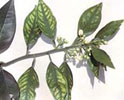 Zinc deficiency is usually most severe in the spring growth. Note that leaves from the previous summer flush are not affected. | 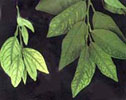 However, when deficiency is severe and is not treated, both the summer flush leaves and the spring flush leaves are affected. |
Use an annual foliar spray (zinc sulphate) on the spring flush leaves when they are about two-thirds their full size (see Table 4). Severely deficient trees need two or more sprays during the season. Use a combination spray of zinc sulphate and manganese sulphate if the tree is also manganese-deficient. Commercial preparations of zinc and manganese are available separately or as a combination.
Manganese (Mn)
Manganese deficiency causes a diffuse pale green mottle between the veins in young and old leaves. The leaf size is normal. A narrow band remains green on each side of major veins. Symptoms are more noticeable on the southern side of the tree.
Spring growth is affected, and both young and mature leaves can show the symptoms. Persistent severe deficiency reduces cropping and growth. Liming can accentuate the deficiency.
Manganese deficiency is best corrected by a foliar spray of manganese sulphate (see Table 4).
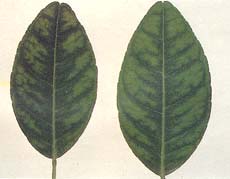 | Manganese deficiency causes a diffuse pale green mottle between the veins in young and old leaves. The leaf size is normal. A narrow band remains green on each side of major veins. Symptoms are more noticeable on the southern side of the tree. Spring growth is affected, and both young and mature leaves can show the symptoms. |
Iron (Fe)
The plant needs iron to produce chlorophyll. Iron deficiency causes a distinct pattern in the leaf caused by a loss of chlorophyll; only the main veins stay green. Iron does not move easily within the plant, so young leaves are the worst affected, showing the symptoms, while older leaves may remain green.

Iron deficiency is sometimes called ‘lime-induced chlorosis’, as it is worse in calcareous (calcium rich) soils with a high pH. This makes iron unavailable. The problem is accentuated where free lime concretions are found near the surface of the soil. A high water table (which causes a low soil-oxygen supply to the roots) or a low soil temperature can further aggravate the problem.
Effective control measures include careful irrigation (avoid overwatering) and the selection of tolerant rootstocks. Do not plant Poncirus trifoliata rootstocks in problem soils, as this variety is more sensitive to iron deficiency than sweet orange, rough lemon or Troyer citrange. Cleopatra mandarin is one of the most tolerant rootstocks if there are no drainage problems. Lemons are more prone to chlorosis than oranges and grapefruit.
Foliar sprays of iron sulphate or iron chelate are ineffective. If a few trees are affected, try iron chelate applied to the soil under the trees; however, this treatment is uneconomic for a large block—management is the only option here.
Copper (Cu)
Copper deficiency (exanthema) was a common problem in coastal areas—the Hills District around Sydney, the Hawkesbury Valley and Gosford. It is now rarely seen on the coast since the use of copper fungicidal sprays.
Copper deficiency is occasionally found in the lower Murray and the MIA, where it causes a variety of symptoms. The leaves are often dark green and smaller than normal, except for a few giant leaves found on vigorous S-shaped branches which emerge from stunted bushy trees. Twig growth is weak and likely to die back. The most characteristic symptom is dark brown gum-pockets which develop on the flat sides of angular young shoots. They have a blister-like appearance. The rind of deficient fruit develops brown gum-stained areas, and the fruit splits.
Copper sprays used for fungicidal purposes readily control copper deficiency.
Boron (B)
Boron deficiency is uncommon in New South Wales citrus. The fruit develops a grey to brown discolouration, with pockets of gum in the white part of the rind. The gum is also found in the flesh, and where the flesh meets the rind. Some seeds are imperfectly developed, shrivelled, brown in colour and embedded in gum.
Fruit which have been injured by spined citrus bug are often wrongly diagnosed as ‘boron-deficient’. Spined citrus bug damage is characterised by discrete dry fruit segments, whereas boron deficiency symptoms are not confined to one or two segments of the fruit. Rind marks, caused by the entry of the insect’s feeding tube, often with an exudation of gum, also distinguish the insect injury from boron-deficiency symptoms.
Citrus is sensitive to an excess of boron and to its use where it is not needed. Only apply a boron fertiliser or spray if you are sure that boron is deficient.
Toxicities
Some elements are harmful to citrus in excess, particularly chloride, sodium, boron and manganese.
Sodium and chloride toxicity
Citrus is sensitive to high concentrations of salt (sodium chloride) in the soil or in irrigation water. The problem is most common in the inland irrigation districts of the mid and lower Murray and the Murrumbidgee. Isolated cases of salt toxicity have also been found on the coast where soils are saline, or irrigation water is brackish.
Salt toxicity causes leaf burn and yellowing, starting near the tip. Leaf fall is heavy and dieback follows. Older leaves show the symptoms first.
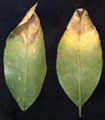 High salt levels in the soil or irrigation water cause yellowing and burning of the leaves. Salt toxicity in oranges. | 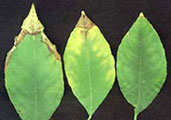 Salt toxicity in lemons. | 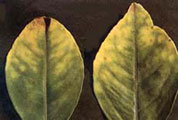 Symptoms of salt toxicity often begin as yellowing and grey or light-brown burn of the leaf tip (above). The burn extends back from the tip (see two photos right) and then develops along the edges of other parts of the leaf edge. A variable degree of yellowing can develop ahead of the burnt tissue. |
Irrigation management and drainage are important factors in minimising salt build-up in the root zone. Salting of orchards in inland irrigation areas can occur when the salt-laden groundwater table rises towards the tree roots. Another cause is the concentration of salt into the ‘dry bone’ areas of the rows, particularly unwetted areas under the trees where furrow irrigation is practised. Faulty distribution of water from spray irrigation systems because of low pressure, strong winds, or too few spray heads, is another way that salt accumulates in localised areas.
Chloride uptake through the leaves can increase the salt problem when the irrigation water is saline (over 500 EC units). Chloride uptake from overhead irrigation is lessened if watering is done at night, when evaporation is lower. Under-tree spray irrigation systems minimise salt uptake through the leaves.
The use of more tolerant scions and salt-excluding rootstocks helps minimise salt injury to trees and loss of production. Lemons are more susceptible than grapefruit or oranges. Citrus on rough lemon rootstock are more susceptible to salt toxicity than those on Troyer or Carrizo citrange, with sweet orange stock being the most tolerant of the stocks commonly used for oranges. P. trifoliata rootstock allows high levels of chloride to accumulate in the tree, whereas Rangpur lime and Cleopatra mandarin stocks are the most effective in excluding chloride, where their use is appropriate.
High sodium levels in the soil damage tree structure and reduce water penetration. Salinity upsets tree nutrition, which leads to reduced potassium uptake. Correcting the salinity often restores normal potassium nutrition. If potassium fertiliser is required in saline areas, use potassium sulphate, not potassium chloride (muriate).
Boron (B) toxicity
Boron toxicity is not common and fortunately appears to be less frequent than it was in former years. It often occurs in inland areas subject to salinity, but it is far less common than salt toxicity. Most cases have been from western irrigated areas, particularly Griffith and some orchards near Dareton and Wentworth. There have also been cases along the Darling River near Menindee and Bourke.
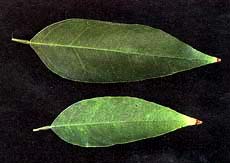
Boron toxicity (like salt toxicity) starts as tip yellowing and tip burn, but subsequent yellowing of the apex tends to be mottled. It progresses into a yellowing of interveined areas near the tip.
Leaf fall is heavy, especially during spring, leading to dieback and reduced cropping.
Irrigation water is not the source of boron accumulation in the main irrigation districts of the MIA and lower Murray. The problem is due to poor drainage or irrigation practices which concentrate the soluble soil boron into the root zone. Leaching irrigations and improved drainage will control the problem.
Rootstocks and scions differ in their susceptibility to boron toxicity. Citrus on rough lemon stock are more affected than those on sweet orange or P. trifoliata rootstock. Lemons are the most susceptible scion, followed by mandarins, grapefruit and oranges.
Manganese (Mn) toxicity
Manganese toxicity symptoms are occasionally found in citrus growing in very acid soils (usually below pH 5.0). The soil may be naturally acidic or have become acidic through continued heavy applications of strongly acidifying fertilisers, particularly sulphate of ammonia.
Toxicity is more common in loamy soil than in sands. Damp, poorly drained soil encourages the build-up of soluble manganese. Lemons, oranges, mandarins and grapefruit are all affected. Trees on P. trifoliata rootstock are the worst affected, but the problem is also found in trees on rough lemon stock.
Yellowing around the outer part of the leaves, especially of the older leaves, is the most characteristic effect of manganese toxicity in lemons. The yellowing is very bright and is described as 'yellow-top'. Affected oranges and mandarins develop dark brown spots 3-5mm in diameter, scattered over the leaves (tar spotting).
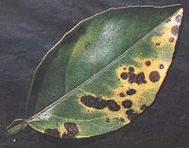 An excess of manganese, usually caused by extreme acidity in the soil, can be toxic. This is seen as dark brown spots (tar spotting) in leaves of the orange tree (above). | 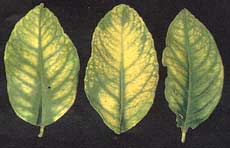 Manganese toxicity in lemons. Note the bright orange-yellow chlorosis (yellow top) in mature leaves. |
Direct your control measures towards correcting soil acidity. Check drainage and, if necessary, correct it. Overcoming soil acidity in an orchard is a slow process, particularly acidity deep in the soil. If lime is applied at 0.5 to1 tonne per hectare, and this application is repeated each year, it can take up to 4 years to correct the toxicity.
Leaf analysis
Leaf analysis is an effective technique for monitoring the nutrient status of citrus trees, for anticipating problems, and for providing a guide to the fertiliser program. It has been the most extensively researched tool for determining the needs of citrus. NSW Agriculture has tested and calibrated the leaf analysis technique for more than 30 years for diagnosis in long-term monitoring studies of over 100 orchards and in its research trials. From this leaf sampling, a procedure (see ‘Taking a leaf sample’ below) and standards (see Table 5) have been developed. NSW Agriculture provides a service for analysing growers’ plant samples (see Laboratory testing services).
Taking a leaf sample
Leaves must be sampled correctly, otherwise the analytical results will be misleading:
Which leaf: The second or third spring-flush leaf from a non-fruiting shoot.
When to sample: Preferably February, but leaves may be collected from late January to mid-March. Such leaves are 4–6 months old. Avoid growth which has made a second flush.
Where on the tree: At about shoulder height from all sides of the tree, or both sides of closely planted rows.
Number of trees: Take leaves from about 20 trees throughout a uniform and representative section of one block, following a zigzag or ‘X’ pattern in the sampled area.
Number of leaves: 60–100 leaves per sample.
Interpreting the leaf analysis, and adjusting fertilisers
By monitoring the leaf nutrient levels in a representative block over a number of seasons, a grower can build up a useful record for managing the citrus nutrition program. The analyses for each season should be compared and considered in relation to previous fertiliser applications, fruit yield and quality, as well as deficiency symptoms, general tree health and vigour. Nutrient levels vary slightly from season to season depending on crop size and environmental effects, so the clearest picture will come from examining trends over several seasons.
If the leaf levels are within the satisfactory range (see Table 5), continue your normal fertiliser program. No dramatic change in fertiliser programs should be undertaken on 1 year’s results alone, but if any of the nutrient levels are consistently low or high, or the analyses confirm symptoms, adjust the fertiliser program or apply appropriate trace element sprays.
For example, if leaf nitrogen is constantly down to 2.0–2.3%, consider increasing nitrogen fertiliser by 100–200 g per tree. If the value is above 2.8% N, reduce the nitrogen, otherwise poor quality fruit will result. Where the production of good quality fresh oranges is of prime importance, leaf nitrogen levels should be kept near the lower end of the acceptable range (about 2.4%).
Leaf potassium can fluctuate from one season to the next, but if the level remains in the low range (0.4–0.6% K) for two or more seasons, apply extra potassium.
Check the credentials of any chemical test. Before a chemical test (of soil, leaf or sap) can provide a reliable guide to the supply of a nutrient to a particular crop, it must first be calibrated to that crop and soil type. For example, a soil test which has been calibrated for wheat or pasture can be misleading if used for citrus. Quick sap tests, which have been calibrated for vegetables or cereals, will not correctly measure citrus needs.
Use the information from chemical tests sensibly. Develop a consistent program, one that does not change dramatically with each season’s leaf analysis, otherwise monitoring becomes impossible. Chemical analysis is only a tool, so don’t let any analysis override commonsense and your knowledge of other factors based on sound experience.
Tables
Table 1. Some fertilisers and manures commonly used on citrus, showing their nutrient content and the quantity of fertiliser needed to supply 100 g N, P or K per tree
| Fertiliser | Nitrogen N % | Phosphorus P % | Potassium K % | Magnesium Mg % | Quantity of fertiliser (grams) needed to supply:(a) | ||
|---|---|---|---|---|---|---|---|
| (b)100 g N | (b)100 g P | (b)100 g K | |||||
| Urea | 46 | 217 | |||||
| Ammonium nitrate (Nitram®) | 34 | 294 | |||||
| Ammonium sulphate | 21 | 476 | |||||
| (c)Grower 16® + Mg | 15.0 | 6.2 | 5.1 | 2.4 | 666 | 1610 | 1960 |
| Citrus 2® | 12.5 | 2.7 | 3.3 | 800 | 3700 | 3030 | |
| Citrus Food® | 10 | 3.9 | 6.2 | 1000 | 2560 | 1610 | |
| Hunter Special® | 8.3 | 3.8 | 7.2 | 1200 | 2630 | 1390 | |
| Banana Special® | 7.3 | 5.1 | 5.0 | 1370 | 1960 | 2000 | |
|
Superphosphate -single | 8.8 | 1140 | |||||
|
Superphosphate -double | 17.5 | 570 | |||||
| Muriate of potash | 50 | 200 | |||||
| Sulphate of potash | 41 | 244 | |||||
| (d)Blood & Bone | 5.0 | 4.0 | 2000 | 2500 | |||
| (e)Poultry manure -high grade | 3.3 | 2.0 | 1.5 | 3000 | 5000 | 6667 | |
| (e)Poultry manure -fair grade | 2.0 | 1.2 | 1.0 | 5000 | 8333 | 10 000 | |
(a) To simplify the calculation of fertiliser rates, some values have been rounded.
(b) To calculate the quantity, in kg/ha, of fertiliser needed to supply 1 kg of N, P or K per hectare, divide the value in Table 1 by 100.
e.g. 100 g of N is supplied by 217 g urea. Therefore, 1 kg of N is supplied by 2.17 kg urea.
(c) The following five NPK fertilisers are representative of a very large number of commercial mixtures offered to orchardists.
(d) The analysis of blood and bone varies from brand to brand. This is a typical analysis.
(e) Nutrient analyses typical for dry manure.
® Registered trademark
Table 2. District recommendations for rates of application of fertiliser nitrogen, phosphorus and potassium
| District | Crop | Soil | Single-planted spacing 6.7 m × 6.7 m (222 trees/ha) | Double-planted spacing 6.7 m × 3.4 m (444 trees/ha) | ||||
|---|---|---|---|---|---|---|---|---|
| N | P | K | N | P | K | |||
| kg/ha/yr | kg/ha/yr | |||||||
|
Central Coast(a) | Oranges & grapefruit |
150 (680)* |
75(d) (340)* |
75(d) (340)* | 180 | 90(d) | 90(d) | |
| Lemon |
150 (680)* |
100(d) (450)* |
100(d) (450)* | 180 | 120(d) | 120(d) | ||
|
MIA & mid- Murray(b) | Oranges & grapefruit | Loam |
100 (450)* |
40(d) (200)* | 0 | 100 | 50(d) | 0 |
| Sandy |
120 (600)* |
50(d) (220)* |
45(d) (200)* | 120 | 60(d) | 50 | ||
| Lemon | Loam |
140 (1000)* |
40(d) (200)* |
45(d) (200)* | 150 | 60(d) | 50(d) | |
| Sandy |
160 (1000)* |
50(d) (220)* |
65(d) (300)* | 180 | 60(d) | 85(d) | ||
|
Lower Murray(c) & Narromine | Oranges & grapefruit | 100 | 30 | 30 | 110 | 40 | 40 | |
* Rate in grams per tree.
(a) Including Gosford, Mangrove Mountain and Windsor areas.
(b) Including Griffith, Leeton, Narrandera and Barham.
(c) Including Dareton, Curlwaa, Wentworth and Baronga.
(d) Application rates for phosphorus or potassium where they are required. Not for routine annual application.
Young trees: For both close and standard planting densities, spread 60 g N/tree/year for each year of tree age after the year of planting until the rate (per hectare) for fully bearing trees is reached. In the year of planting, a light dressing of 20–30 g N/tree may be applied during summer.
NOTE: These recommendations are only a general guide for citrus in the main New South Wales production districts. Contact your NSW DPI District Horticulturist for specific advice.
Table 3. Solubility and composition of some fertilisers used for fertigation
| Fertiliser | Solubility kg/1000 L(a) | Nutrient content | |||
|---|---|---|---|---|---|
| 10°C | 20°C | N% | P% | K% | |
| Urea | 350 | 450 | 46 | – | – |
| Ammonium nitrate | 240 | 480 | 34 | – | – |
| Urea—ammonium nitrate solution (Easy N)® | – | – | 32(b) | – | – |
| Calcium nitrate | 400 | 600 | 15.5 | – | – |
| Potassium nitrate | 100 | 160 | 13 | – | 38 |
| Potassium chloride | 200 | 300 | – | – | 50 |
| Potassium sulphate | 50 | 70 | – | – | 40 |
| Monoammonium phosphate (MAP)(c) | 160 | 200 | 12 | 26 | – |
(a) Weight of fertiliser readily soluble at 10°C and 20°C.
(b) Sold as liquid—100 L of 32% N w/w supplies 42.5 kg N.
(c) Applications of phosphorus fertiliser through irrigation systems can cause precipitation in the lines and blocked drippers. Fertiliser grade MAP contains insoluble residue which can also block drippers.
® Registered trademark
Table 4. Treatment for correcting deficiencies of magnesium and the trace elements in citrus
| Nutrient deficiency | Treatment | Application rate | Timing | Remarks |
|---|---|---|---|---|
| Magnesium | Sprays | |||
| Magnesium nitrate | 1 kg/100 L | When spring flush leaves are 1/2 to 2/3 expanded. | Repeat sprays annually. | |
|
Alternative spray:(a) magnesium sulphate (Epsom salts) + calcium nitrate | 1 kg/100 L 1 kg/100 L | As above. | Mix magnesium sulphate in a half-full vat, then add calcium nitrate separately while agitator is running. Then fill vat. | |
| Soil | ||||
| Magnesite | 0.5–1 t/ha | Any time, but preferable before a cultivation. | Slow but long-lasting on acid soils. Use sprays for citrus on neutral or alkaline soils. | |
| Magnesium oxide | 250 kg/ha | |||
| Dolomite(b) | 2–5 t/ha | |||
| Zinc | Sprays | |||
| Zinc sulphate heptahydrate (23% Zn) | 150 g/100 L | When spring flush leaves are 1/2 to 2/3 expanded. | This spray is simple to mix and causes minimum residue. | |
| Commercial liquid preparations | As per the label | |||
|
Zinc sulphate (23% Zn) + hydrated lime |
500 g/100 L 250 g/100 L | This spray leaves a white residue but is more durable if rain is likely within 48 hours. | ||
| Manganese | Sprays | |||
| Manganese sulphate | 100 g/100 L | As above. | 500 g urea is often added to improve uptake of manganese. | |
| Commercial liquid preparations | As per the label | |||
| Zinc and manganese | Sprays | |||
|
Zinc sulphate (23% Zn) + manganese sulphate |
150 g/100 L 100 g/100 L | As above. |
Zinc and manganese deficiencies often occur together. A combined spray is an effective means of controlling both. The first spray is usually preferred but should not be used if rain is expected within 48 hours. The third spray leaves residue on the fruit and leaves. | |
| Commercial preparations containing both elements | As per the label | |||
|
Zinc sulphate (23% Zn) + manganese sulphate + hydrated lime |
500 g/100 L 300 g/100 L 250 g/100 L | |||
| Copper | Sprays | |||
| Copper sulphate (commercial mixes) | As per the label | Spring or autumn to suit fungicide program. | Normal copper fungicides for blackspot, septoria or greasy spot, or for snail control, will usually meet the copper needs of the trees. | |
| Copper oxychloride | As per the label | As above. | ||
| Copper hydroxide | As per the label | As above. | ||
(a) Where magnesium nitrate is difficult to obtain.
(b) Some dolomite sources are of poor quality. If high-grade dolomite (8%-10% Mg) is not obtainable, use magnesite.
Table 5. Leaf analysis standards for citrus
| Element | Deficient range(a) | Low range | Satisfactory range | High range | Excess range |
|---|---|---|---|---|---|
| As percentage of dry matter of leaf | |||||
| Nitrogen(b) | Below 2.20 | 2.20–2.39 | 2.40–2.69 | 2.70–3.00 | Above 3.00 |
| Phosphorus | Below 0.10 | 0.10–0.13 | 0.14–0.16 | 0.17–0.30 | Above 0.30 |
| Potassium | Below 0.40 | 0.40–0.69 | 0.70–1.30 | 1.31–2.00 | Above 2.00 |
| Calcium | Below 1.60 | 1.60–2.90 | 3.00–5.50 | 5.60–7.00 | Above 7.00 |
| Magnesium | Below 0.16 | 0.16–0.29 | 0.30–0.69 | 0.70–1.00 | Above 1.00 |
| Sodium | Below 0.16 | 0.16–0.25 | Above 0.25 | ||
| Chlorine | Below 0.30 | 0.30–0.60 | Above 0.60 | ||
| Sulphur | Below 0.14 | 0.14–0.19 | 0.20–0.39 | 0.40–0.50 | Above 0.50 |
| As mg/kg (parts per million) dry matter of leaf | |||||
| Manganese(c) | Below 16 | 16–24 | 25–100 | 100–300 | Above 300 |
| Zinc(c) | Below 16 | 16–24 | 25–100 | 100–200 | Above 200 |
| Copper(c) | Below 3 | 3–5 | 6–15 | 16–20 | Above 20 |
| Boron | Below 21 | 21–30 | 31–129 | 130–260 | Above 260 |
(a) Levels in the deficient range can result in marked reduction in yield, deficiency symptoms, or both.
(b) The satisfactory range for grapefruit is 2.0–2.2% N.
(c) Leaves sprayed with nutritional or fungicidal sprays containing manganese, copper or zinc will analyse ‘high’, and results cannot be interpreted.

